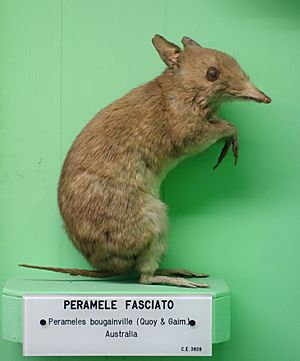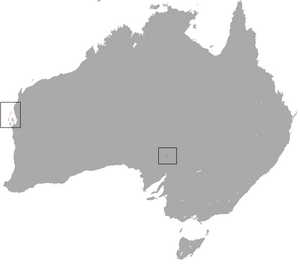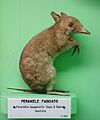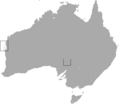Western barred bandicoot facts for kids
Quick facts for kids Western barred bandicoot |
|
|---|---|
 |
|
| Conservation status | |
| Scientific classification | |
 |
|
| Western barred bandicoot range (red—native; pink—reintroduced) |
The Western barred bandicoot (Perameles bougainville), also known as the Marl, is a small bandicoot found in Australia. These animals are much smaller than their relatives, the eastern barred bandicoots. They are also darker in color, usually a grizzled brown.
Contents
What is a Western Barred Bandicoot?
The Western barred bandicoot is about 45 centimeters (1.5 feet) long. It has two dark stripes, or "bars," across its back. Its tail is short and gets thinner at the end. This bandicoot is a shy animal. It hunts mostly at dawn and dusk, or at night. It eats insects, spiders, and worms. Sometimes, it also digs up tubers and roots to eat. When it feels scared, it jumps into the air. Then, it quickly burrows into the ground to hide.
Where Do Bandicoots Live?
Long ago, Western barred bandicoots lived all over southern Australia. They were found from Western Australia to New South Wales and Victoria. They lived in dry and semi-dry areas. The last time they were seen on mainland Australia was in 1929. This was in Rawlinna, Western Australia.
Today, the only natural groups of these bandicoots live on two islands. These are Bernier and Dorre islands. Both islands are in Shark Bay in Western Australia.
Reintroduction Efforts
Scientists have been working to bring these bandicoots back to other areas. In 1995, some were moved to Heirisson Prong in Shark Bay. This effort did not work out, and they are now gone from there.
However, other reintroduction projects have been successful!
- In 2000, bandicoots were moved to the fenced Arid Recovery Reserve. This is near Roxby Downs in South Australia.
- In 2005, they were brought to Faure Island in Shark Bay.
- In 2017, more bandicoots were moved to Mount Gibson Sanctuary in Western Australia.
- In 2019, they were reintroduced to Dirk Hartog Island.
More reintroductions are planned for three large fenced areas in New South Wales. These places are the Pilliga Forest, Mallee Cliffs, and Sturt National Park.
There are also captive groups of bandicoots. You can see them at the Barna Mia Nocturnal Animal Sanctuary. This sanctuary is in the Dryandra Woodland in Western Australia.
Bandicoot Life and Reproduction
Western barred bandicoots are solitary animals. This means they usually live alone. They find their own food. They eat plants, insects, and small lizards. They build a hidden nest from leaves and other plant material. They often use the same nest every night. Female bandicoots sometimes share their nests, but only with their babies.
The breeding season starts after the first big rain in autumn. Female bandicoots can have babies when they are 3 to 5 months old. They usually weigh about 244 grams (8.6 ounces). A female carries 1 to 3 young in her pouch. On average, she has 2 babies at a time. Larger mothers tend to have more babies. Females carry their young from March to November.
Male bandicoots become adults at 4 to 6 months old. They weigh about 195 grams (6.9 ounces). Interestingly, female Western barred bandicoots are larger than the males. This is the only bandicoot species where the female is bigger.
Health Challenges
In 1999, a skin disease was found in some bandicoots. It caused wart-like growths. This disease was first seen in bandicoots living in captivity. Later, it was found in wild bandicoots in 2001. It is a new disease for Australian marsupials.
This disease mostly affects adult bandicoots. It usually starts when they are about 3 years old. The growths get bigger and can make them very sick. Infected bandicoots live about 1 year and 4 months after getting the disease. Today, this disease is mostly found on Bernier Island. It is also in captive groups that came from Bernier Island.
Who Hunts Bandicoots?
Native animals like the Gould's monitor (a type of lizard) and the western quoll sometimes hunt bandicoots.
However, the biggest threats come from animals brought to Australia by humans. These are called introduced species.
- Feral cats are a major problem. They are believed to have caused many native mammals to disappear.
- Foxes also hunt bandicoots and other small Australian mammals.
- Rabbits are not predators, but they cause problems. They eat the plants that bandicoots need for food and shelter. When there are fewer rabbits, bandicoots tend to have more babies.
Scientists tried to protect bandicoots on Heirisson Prong. They built a fence in 1990 to keep out foxes and feral cats. Even with the fence, cats still got in. This led to the bandicoots disappearing from Heirisson Prong in 2008.
Protecting the Western Barred Bandicoot
Efforts to save the Western barred bandicoot have been happening since 1995. Scientists are working hard to protect them.
One challenge is that these bandicoots have low genetic diversity. This means their genes are very similar. Low diversity can make a species weaker. It makes them more likely to get sick. It also makes them less able to adapt to changes in their environment. This is why the disease mentioned earlier is a big concern.
The few remaining groups of Western barred bandicoots live in small areas. They are very sensitive to human activities. They are also affected by climate change, diseases, and predators. All these things put a lot of pressure on them. Because of these challenges, the species is at risk of becoming critically endangered or even extinct very quickly.
Conservation Status
The Western barred bandicoot is listed as a species that needs protection. Here are some of its conservation listings:
- International: It is listed as Vulnerable by the IUCN. This means it faces a high risk of extinction in the wild.
- National (Australia): The P.bougainville bougainville group from Shark Bay is listed as Endangered. This is under the Australian Environment Protection and Biodiversity Conservation Act 1999.
- National (Australia): The P.bougainville fasciata group (eastern) is listed as Extinct under the same Australian Act.
- Western Australia: It is listed as Vulnerable under the Biodiversity Conservation Act 2016.
- South Australia: It is listed as Endangered under the National Parks and Wildlife Act 1972.
- Victoria: The eastern subspecies is listed as Extinct under the Flora and Fauna Guarantee Act 1988.
- New South Wales: The mainland group is listed as Extinct under the NSW Biodiversity Conservation Act 2016.
Images for kids
See also
 In Spanish: Tejón marsupial rayado para niños
In Spanish: Tejón marsupial rayado para niños




